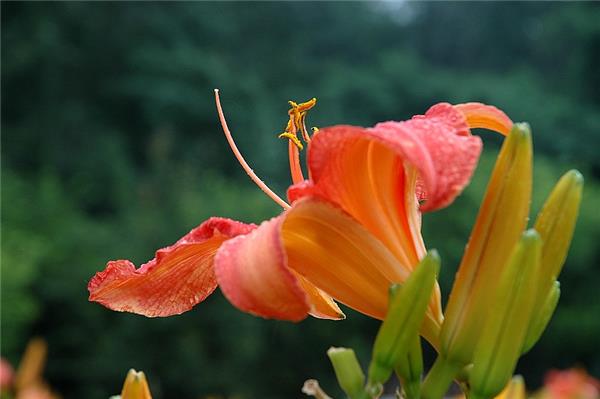Cultivation and pest control methods of Hemerocallis fulva
Hemerocallis is a typical flower-watching plant, which has elegant shape and charming colors. It can not only beautify the environment, but also make people feel physically and mentally happy in home breeding.

I. Propagation mode of Hemerocallis davidii
1. Split-plant propagation: dividing day lilies into clumps is the most commonly used culture method. The operation of this method is simple, the plant is easy to survive and the growth is consistent. Ramet can dig out all the mother plant cluster and replant it, or dig out a part of the plant from one side of the mother plant cluster to make seedlings, leaving behind to continue to grow.
two。 Sowing and propagation: sowing is a method of rapid and mass production of seedlings, but because of the low germination rate of seeds, it needs to be soaked and germinated first and can be planted one year after sowing. Enter the seed collection period around September every year, which requires strong plant growth, full fruit and no diseases and insect pests. Sow the seeds in the following spring.
3. Split bud flower bud refers to the small plant on the stem of Hemerocallis. The flower bud can be cut from the flower stem and, if large, can be further divided before planting. The transplanted flower buds can take root after a week. The rooting flower buds can be used to cultivate plants, increase the number of plants planted, and finally improve the economic benefits.
4. Tissue culture propagation: tissue culture used young leaves, filaments and flower moss and other organs to culture plants. The method is to induce young organs to produce callus, and then use appropriate medium to culture young plants under suitable conditions such as warm and humid phosgene. Then the seedlings were pseudo-planted in the nutrition bowl, and the seedlings were cultivated for a period of time, and then planted.

Maintenance measures of Hemerocallis davidii
Fertilization: hemerocallis hemerocallis has a long flowering period and has a large demand for nitrogen, phosphorus and potassium. In addition to applying sufficient basic fertilizer (suitable for rotten cow manure or pig manure), it is also necessary to apply fertilizer according to the needs of different stages of development. When the nitrogen is sufficient, it can promote the robust growth of the plant and increase the leaf size.
Watering: Hemerocallis has strong drought resistance and little water demand in the vegetative growth period, so it should be irrigated according to the water needs of each growth and development period of Hemerocallis, combined with the local climate, soil and water sources. After transplanting new seedlings, it is necessary to maintain soil water holding capacity of 70% to 80%, and water in a timely manner during drought. The plant at seedling stage is small, and the water demand is also small. Starting from reproductive growth, water demand increases gradually, such as lack of water at this time, will affect growth.
Weeding: weeding in the middle tillage should be carried out when the soil moisture is moderate, and can be stopped after the leaves cover the land. Timely removal of weeds in day lily fields, if weeds are clustered, it is easy to cause diseases and insect pests, affecting the growth and appearance of day lilies.

III. Pest control of Hemerocallis davidii
Hemerocallis hemerocallis is prone to diseases, mainly scab and leaf blight. Scab is a kind of flower disease caused by the infection of rust fungus in the order Rust. It is a fungal disease. It generally occurs in the middle and late stage of Hemerocallis, in early May and seriously from June to July, which mainly harms the leaves and moss of Hemerocallis. After the rust spores fly, the leaves and moss die. Spraying 25% pink rust rather than 800 times of wettable powder once every 20 days, the control effect can reach more than 90% after three times. Leaf blight, caused by pathogenic fungi of the genus Alternaria, is a seedling disease after leaf spot. In general, the disease began in early May and occurred seriously in the first and middle of June, mainly harming leaves and flower moss, and the whole plant withered and died in serious cases. Spray with 70% chlorothalonil 500-600 times or 65% Dysen zinc 500 times every 10-12 days.
Hemerocallis is prone to insect pests, mainly red spiders and aphids. The control of red spider is mainly sprayed with 40% diclofenac EC 1000-1500 times or 20% mifenjing wettable powder 2000 times, which can achieve the ideal control effect. The control of aphids is mainly controlled by spraying 10% imidacloprid wettable powder 1000 times or 2.5% aphid lice EC 3000 times.

Hemerocallis is a perennial herb, which can be said to save both time and effort when raising it at home, so if you are interested in raising it, take action.
- Prev

Classification and Price reference of Landscape Tree species
Classification and Price reference of Landscape Tree species
- Next

Matters needing attention in Culture and embodiment of Medicinal value of Lampstand Tree
Matters needing attention in Culture and embodiment of Medicinal value of Lampstand Tree
Related
- Wuhan Hospital Iron Tree Blooming Result Was Instantly Frightened by the Gardener Master
- Which variety of camellia is the most fragrant and best? Which one do you like best?
- What is the small blue coat, the breeding methods and matters needing attention of the succulent plant
- Dormancy time and maintenance management of succulent plants during dormancy
- Minas succulent how to raise, Minas succulent plant pictures
- What are the varieties of winter succulent plants
- How to raise succulent plants in twelve rolls? let's take a look at some experience of breeding twelve rolls.
- Attention should be paid to water control for succulent plants during dormant period (winter and summer)
- Watering experience of twelve rolls of succulent plants
- Techniques for fertilizing succulent plants. An article will let you know how to fertilize succulent plants.

